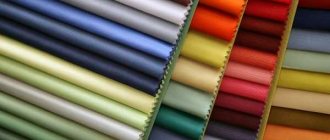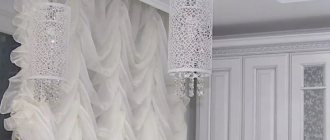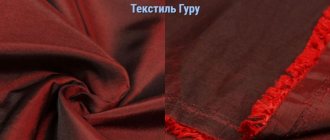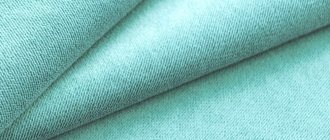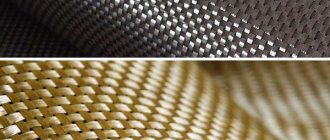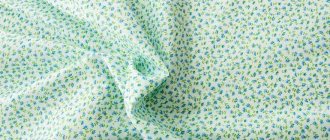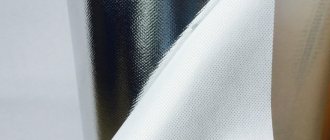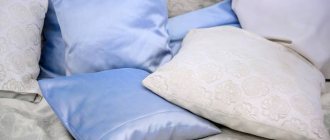Double thread fabric - what is it?
The description says that the basic version is a harsh, durable material of rough manufacture. It is not subject to additional processing.
There is also a finished two-thread - not everyone knows what it is. This is a fabric that can be further processed.
What is a double thread? This is a fabric woven from double threads. It has several varieties.
Double thread
Gozhka
It has a standard plain weave. Unbleached cotton is used in production. The work consists of several stages:
- Using a loom, a harsh fabric is produced that has a gray tint. In some cases, it goes to work as is. The harsh canvas is used for packaging, crafts, and organizing space in eco-style.
- The harsh fabric is impregnated with an adhesive containing starch, an antiseptic and a substance that softens the fibers.
- The canvas is stretched so that there are no deformations or distortions on it.
- At the last stage, it is processed with calender rollers to achieve smoothness.
Gozhka
Satin
This is a fabric with a smooth shiny surface. For production, cotton is used that has undergone mercerization (that is, cotton fiber is dipped into a solution of alkali and acid in turn). This fiber becomes stronger and lends itself better to dyeing. Next, satin is woven from twisted threads (the more twisted the threads are, the more expressive the fabric will be). At the last stage it is bleached and stained. Any colors and prints fit perfectly on this canvas.
Satin
Atlas
The production of such fabric is very similar to the production of satin, however, the latter has four or more warp threads overlapping the wefts, while satin has several weft threads.
Atlas
Jacquard
This is a fabric with a complex weave of a large number of threads.
You may be interested in what is decorative, jute or linen burlap for needlework
Two-thread severe
Double thread is a harsh fabric that deserves special attention. It turns out to be rough to the touch at the first stage of double-thread manufacturing. This fabric is produced with a special finishing - sizing, which significantly improves consumer qualities.
Double thread satin
For your information! In general, if the fabric does not go to the next stages of double-thread production, then it is dried, deformations are eliminated, and smoothed. The result is a wear-resistant, moisture-resistant, airtight, heat-resistant fabric.
A harsh two-thread thread is not suitable for all products. It is widely used in the production of work clothes (especially for firefighters or employees of hot shops), furniture, insoles, art hosts, bags, and children's toys.
Caring for a severe one is no different from caring for a regular two-thread one.
Note! It turns out that there is a double-thread knitwear knitted from two threads. They also call it footer. They are made mainly from cotton, sometimes synthetics are added.
Harsh
Two-thread harsh (not sizing). Cotton 60%, WPEF 40%. Density 160 g
PRICE: 43.00 rub.
per linear meter. Add to cart If we describe the specific use of the material, bleached double thread is used for sewing the following household items:
- sportswear - the hygroscopicity of the fabric provides comfort during physical activity, and anti-allergenicity makes such clothing accessible to a wide range of people;
- work and casual clothing - the affordable price and practicality of the material are the main reasons for its use as protective and industrial uniforms;
- summer dresses - “breathable” lightweight fabric becomes especially valuable during hot days;
- bags and lining sections for them;
- furniture upholstery;
- packaging products;
- binding of printed books;
- shoe elements;
- postal packaging;
- containers for collection.
Fabric requirements
According to GOST, double-thread fabric must meet the following requirements:
- produced from cotton yarn (linen, etc.), which complies with regulatory and technical documentation;
- the fabric is produced in widths of 90 cm (the permissible deviation can only be ±1.5 cm if the consumer agrees), 100 cm (the permissible deviation is ±2.0 cm), 310 cm (the permissible deviation is ±3.0);
- the finished fabric must be cut on both sides and calendered;
- with a nominal surface density of up to 500 g/m², the breaking load of the warp should normally be from 90 (92) daN, of wefts from 65 (67) daN, and with a density of 500 g/m² of warp - from 105 (107) daN, wefts - from 100 (102) daN. The tearing load of the warp is from 17.6 (18) daN, the weft - from 15.6 (16) daN.
Double-thread children's clothing
Important! Double thread stretches well if polyester fiber is added during production. Despite this, products made from such fabric retain their original appearance for a long time. Most often, Turkish double-thread is subjected to this treatment.
Cloth
Caring for double-thread fabric is quite simple: it tolerates dry cleaning and machine washing at a temperature not exceeding 30 ° C with mild detergents, wring at a low speed. To wash, turn the item inside out and then dry it away from heating devices and direct sunlight. Products made from double thread often do not need ironing. It is important to read the instructions on the label before washing.
You might be interested in what cashkorse is: the constituent components of the material, features of use
Sports suit
Rules of care
When caring for double thread, you should remember that this is a material with a high cotton content. It is important to follow the rules and recommendations that are indicated on the label.
Basic recommendations for products made from double-thread fabric:
- Products can be washed at a water temperature not exceeding 30 0C.
- The fabric does not wrinkle, but if there is a need to remove wrinkles that have formed, you can iron it with an iron set to the “Cotton” mode.
Double-thread fabric is reliable, strong and durable, endowed with positive properties and an attractive appearance. With proper and careful care, it will retain all these qualities for a long time.
Areas of use
Due to its strength, double-thread material has a very wide range of applications, which depends on the density and type of structure (for example, for embroidery, the cells must be visible, but for clothing, on the contrary, the fibers must be tightly woven). This fabric is most often used to produce:
- protective work clothing (robes, jackets, overalls, gloves, pants, etc.);
- upholstery for furniture (usually used for the back wall of various furniture elements);
- book bindings;
- canvases for painting;
- packaging materials;
- lining for clothes and shoes;
- bed sheets;
- casual clothes (raincoats, tracksuits, underwear, T-shirts, trousers, etc.);
- shoes (sneakers and sneakers);
- children's clothing;
- canvases for embroidery.
Double thread embroidery
Characteristics, composition and types of fabric
In our country, double-thread material is very common. What kind of fabric this is is clear from the name. In its production, paired threads are used . It is thanks to this weaving that the material has increased strength and is not afraid of water and fire. Initially, it consisted of 100% cotton, later manufacturers began to add various synthetic fibers to it. What kind of fabric you get depends, first of all, on the method of processing it.
Types of double thread
The following types of double-thread are distinguished:
- Harsh. Rough linen fabric with a 2 by 2 thread weave is called rough or raw. This processing method does not imply the addition of any synthetic fibers or additional processing methods to the weaving. It has increased strength, wear resistance, and does not deform when washed at high temperatures. The material is well ventilated and dries quickly.
- Double thread finished. Experts call the fabric, which includes synthetic thread, treated and impregnated with a special impregnation, finished fabric. The average buyer knows this type of fabric as knitwear. The basis of this fabric remains cotton. The advantage of knitwear is its elasticity, strength, and good water permeability.
- Footer is a type of knitted sweatshirt. This is an equally durable material, soft and pleasant to the body. The front side of the fabric is smooth, the back side resembles a small terry loop (combed). Footer with fleece is popularly called three-thread. The composition includes cotton, sometimes it is combined with synthetic thread. Footer is widely used for sewing children's clothing and accessories, sports suits.
- Jacquard - has many variations. The composition may contain cotton, polyester, viscose or any other synthetic raw material. This variation of the material is used for sewing curtains, tablecloths, bedding, scarves, etc.
- Diving - the type of weaving of this material is identical to knitwear. But unlike it, diving does not contain cotton threads. As a rule, the manufacturer combines polyester, viscose and elastane. This fabric has high strength, elasticity and hypoallergenicity. Diving has become a very popular material in recent times. It is widely used when sewing tracksuits and other clothing.
Double thread footer
This is a very dense (170-350 g/m²) soft bi-elastic knitwear, the front side of which is finely knitted and smooth, and the back with a pile. This fabric is made by tying together two threads. To make the material elastic and wear-resistant, the footer is rarely made from 100% cotton; more often, about 20% synthetics or viscose are added to it.
Note! Footer is not always a two-thread fabric. Sometimes it is made from an interlacing of three threads.
In both cases, the footer has a number of advantages:
- absorbs moisture;
- breathable;
- keeps warm;
- does not form pellets;
- does not stretch during wear;
- not picky about care;
- has a wide variety of colors and prints.
The footer is ideal for sewing children's and home clothes, suits.
Home clothes
Double thread bleached (not sizing) 100% cotton. Density 256 g/m2
PRICE: 167.00 rub.
per linear meter. Add to cart Delivery is made anywhere in Russia. The delivery price depends on the parameters and quantity of products ordered. The “Delivery” tab or contacting support specialists via messages in the interactive communication form will help you calculate the approximate cost and decide on the delivery method. Qualified employees will help you sort out any questions you may have and tell you in detail about the features of the product and the most convenient ways to purchase it.
TABLE OF CARGO PARAMETERS for calculating the cost of transportation | ||||||||
| Description of goods | vendor code | Density (g/sq.m.) | Roll length (m) | Roll width (m) | Roll height (m) | Roll volume (m³) | Roll weight (kg) | Approximate quantity per roll (m) |
| Double thread bleached | 087 | 260 | 1,5 | 0,28 | 0,11 | 0,05 | 18,00 | 40-50 |
| Two-thread severe | 104 | 190 | 0,9 | 0,28 | 0,11 | 0,03 | 17,00 | 90-110 |
| Two-thread severe | 107 | 210 | 0,9 | 0,28 | 0,11 | 0,03 | 18,00 | 90-110 |
| Two-thread severe | 108 | 240 | 0,9 | 0,28 | 0,11 | 0,03 | 21,00 | 90-110 |
| Two-thread severe | 220 | 200 | 0,9 | 0,28 | 0,11 | 0,03 | 18,00 | 90-110 |
| Two-thread severe | 240 | 220 | 0,9 | 0,28 | 0,11 | 0,03 | 19,00 | 90-110 |
| Double thread finished | 104 | 200 | 0,9 | 0,28 | 0,11 | 0,03 | 19,00 | 100 |
| Double thread finished | 107 | 220 | 0,9 | 0,28 | 0,11 | 0,03 | 19,00 | 100 |
| Double thread finished | 240 | 240 | 0,9 | 0,28 | 0,11 | 0,03 | 22,00 | 100 |
Double-thread bleached: scope and advantages.
Pros and cons of double thread
Advantages:
- strength and wear resistance due to density;
- inflammability and heat resistance to high temperatures, which allows the production of high-quality work clothes;
- light fastness, due to which things do not fade;
- does not deform;
- allows the body to breathe when worn;
- crease resistance, which allows you not to waste extra time on ironing products;
- moisture permeability, i.e. things will not rot when wet;
- elasticity, but despite the fact that the fabric has excellent stretch, it does not stretch or sag after a couple of socks;
- wide range of applications;
- low cost, accessible to everyone.
Varieties of material by color
Disadvantages:
- when using double-thread fabric as a canvas, it is necessary to cover it with glue, since the fabric is subject to deformation from the effects of oil paints;
- When sewing products, the fabric frays a lot, so you should always take it with a reserve.
You might be interested Features of twill weave
Bright colors
Advantages and disadvantages
A harsh and finished two-thread has the following advantages:
- High density. The product is resistant to various damages and retains its original appearance for a long time.
- The material is resistant to high temperatures.
- The fabric does not fade for a long time, the color remains even after frequent washing.
- High elasticity leads to low creasing.
- Textile material retains its shape for a long time.
- Most varieties of natural double thread have high air permeability.
- The finished double thread is resistant to rotting.
- Absorbs and retains moisture.
- Mixed fabrics containing lycra, nylon and other synthetic threads look attractive.
- The products are easy to wash.
- Affordable price.
- Hypoallergenic.
- Various colors.
Double thread has some disadvantages:
- The raw ends of the fabric fray, which increases material consumption.
- When wet, the fabric becomes stiff and heavy.
- Fabric with a high content of synthetic fibers practically does not allow air to pass through, creates a “greenhouse effect”, and does not retain heat.
For your information. The harsh double thread is deformed under the influence of oil paints. Before creating art, the artist must treat the canvas with glue.
Customer Reviews
Marina, 37 years old: “Lounge clothes are very annoying, especially pants that stretch out the knees. Literally a few wears, a couple of washes, and no longer looks good. I read on the forums that clothes made from double-thread fabric with lycra wear well. I finally found it in the store and couldn’t be happier. In addition to home clothes, I now love tracksuits made from double-thread fabric. The price is excellent, they do not shrink, do not stretch, have been worn for several seasons and do not lose their appearance. My husband also appreciated the quality, since such clothes are comfortable to wear both in everyday life and outdoors. It gets washed very often. The fabric does not fade."
Double-thread tracksuit
Svetlana, 53 years old: “In reviews I came across many complaints about the shrinkage of products after washing. There is a simple solution to this remark: I buy fabric with lycra (it should contain 20% or more). Then the problem with shrinkage disappears. If the fabric for a product made of 100% cotton is fundamentally important, then it is better to take a reserve of 15-20%. This will give the desired size after decating.”
Olga, 40 years old: “Two-thread knitted fabric is great for baby diapers. The products are soft and gentle for children's skin, without hard folds or creases. Such diapers hold well and do not unravel, like, for example, chintz. Very often, when swaddling, I fold the free edge and do not secure it with anything else. We also tried to purchase rompers, bodysuits, and undershirts made from double thread and were satisfied. The clothes are soft, long lasting, warm and comfortable. In addition to children's clothes, after reading reviews, we decided to sew work clothes for my husband from double thread. Been wearing it for a long time. Now I can say with confidence that the fabric is very durable and will last for many years. The downside is that the fabric frays catastrophically; when sewing, you just need to overlock it right away.”
Dress for home
In general, having figured out what kind of double-thread fabric this is, everyone will draw conclusions for themselves. But the overall assessment of people who have tried double-thread products is quite high, especially if we take into account the price-quality ratio. The only thing that all seamstresses note is that the fabric is very finicky to work with, but clothes made from it will always look good.
Description or why double-thread is wonderful
The manufacturing method and special impregnation explain the excellent qualities of the material.
- Immutability. The fabric does not shrink or wrinkle.
- Heat resistance and non-flammability. The material has a smooth, cropped surface treated with a fire-retardant compound. The products can withstand high temperatures and can be used in “hot” shops.
- Indelibility, durability and increased wear resistance. Possessing a high surface density (180-250 g/m2) and a strong texture, double-thread cotton fabric is comparable in strength and even appearance to the legendary denim of the early 70s.
- Breathability. Natural cotton fabric does not create a greenhouse effect. This is a breathable, fairly soft and very comfortable material to wear.
- Hydrophobicity. The fabric can be safely called waterproof. The drops simply run off the surface without penetrating deep into the fibers.
- Resistance to fungal infections. The material is not afraid of dampness, it is not susceptible to rot.
Attention!
The disadvantages of double thread include high flowability, which the tailor must take into account when sewing products from this fabric.
